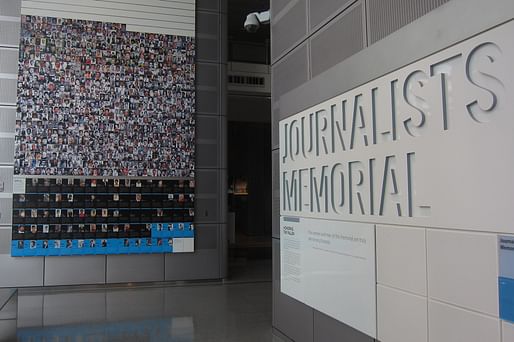

On June 24th, the Fallen Journalists Memorial (FJM) Foundation announced its partnership with global engineering and infrastructure firm AECOM, Pulitzer Prize-winning architecture critic Paul Goldberger, and the Levinson Group on a new site that pays homage to journalists worldwide. The FJM Foundation commits to memorializing and amplifying the work of these individuals whose lives were lost while in service to pursue the truth.
The memorial is "the culmination of dedicated work by the Fallen Journalists Memorial Foundation to honor the reporters, photojournalists, producers, editors, and others in the field, who have died while performing their jobs as journalists," shared Claire Sale, AECOM's project manager overseeing the memorial project. "We are honored to have a role in bringing this memorial to life."
The initiative stemmed from the Fallen Journalists Memorial Act that Congress passed in December 2020. The bill authorized the planning and development of "a commemorative work on federal land in commemoration of America's commitment to a free press as represented by journalists who sacrificed their lives in service to that cause."
To bring the project to light, the FJM Foundation welcomes the expertise of AECOM, who will assist in the planning and site analysis for the project. The firm will undergo a study to help find a site in D.C. fit for the project's criteria of "universal accessibility, program suitability, tranquility, site prominence and visibility, resiliency and sustainability, security and maintenance, and transportation access."
Goldberger will assist in selecting the site's architect, providing input with site selection, and creating a plan to help determine the site's overall design process. For the award-winning journalist, his career within architecture and media as a renowned critic, editor, and educator will aid the project team in having a strong vision for the memorial's execution.
Memory is re-inscribed by repetition. So having a site for memorialization, which can be returned to, is important [...] Each visit is an emotional investment, and memorials require that investment — to mean anything, they have to mean something to those who will stand in front of them. There is a dynamic relationship between object and viewer."
Memorials commemorate the past and those lost. Architecture's evolving relationship with these spaces has taken many physical forms. Architects continue to paint a new picture of how loss and memory can be translated into shared spaces of solace. Projects like MASS Design Group's Gun Violence Memorial Project or the University of Virginia's Memorial to Enslaved Laborers led by Höweler+Yoon alongside UVA alumna Mabel O. Wilson have garnered additional perspectives towards architecture's impact on memorial design.
Projects like these have provided new ways for mourning and remembrance to materialize through monuments and public spaces. "The Gun Violence Memorial is not a memorial in which architecture is abstracted to represent an idealized form of memorialization but one in which architecture itself is at the service of the project and the people," explained architect and writer Eddie Blake and architecture researcher and journalist Gian Luca Amadei. Their piece in Metropolis Magazine, Memorials are for the living, discusses how "architecture mediates between the private experience of loss and the context of public space."
They add, "Memory is re-inscribed by repetition. So having a site for memorialization, which can be returned to, is important. People can go there but also know it is there, as a repository even when no one is present. Each visit is an emotional investment, and memorials require that investment [...] there is a dynamic relationship between object and viewer."
The Fallen Journalists Memorial is another example of how architecture has the opportunity to pay reverence and educate the public while creating spaces for remembrance. With the help of firms like AECOM and individuals like Goldberger, this memorial has the opportunity to articulate a material relationship between those living and those lost. As Blake and Amadei conclude in their piece: "Architecture almost always represents a collective effort, even if the reward for that effort is rarely equitably distributed. In this sense, it is greater than the sum of its parts." This statement is fitting when compared to the work and efforts of journalists.
Recently, the Foundation announced receiving two substantial grants from the Annenberg Foundation and the John S. and James L. Knight Foundation totaling $6 million. Funding will aid in building and supporting a permanent memorial in Washington that also includes educational programming to shed light on the risks hundreds of journalists and photojournalists undergo every year.
This memorial will be an enduring tribute to journalists from all manner of media who have died because of their craft. It's also a stark reminder to those who routinely spew hate about media, that there are real-life, tragic consequences..."
"Hundreds of journalists and photojournalists are attacked, imprisoned, and worse because of what they do," shares Wallis Annenberg, Chairman, President, and CEO of the Annenberg Foundation. "We need to rededicate ourselves to protecting our precious press freedoms and those who put their lives on the line to advance them — word by word and day by day." Architecture, like journalism, can express a collection of narratives that can both unite and divide. This memorial will serve as a reminder of the scale on which journalists impact daily life.
Alberto Ibargüen, Knight Foundation President, adds that while this memorial will be a physical tribute to those lost, it also serves as a nudge to those who degrade and devalue the work of journalists. "This memorial will be an enduring tribute to journalists from all manner of media who have died because of their craft. It's also a stark reminder to those who routinely spew hate about media that there are real-life, tragic consequences to their cheap shots and threats."
To learn more about the Fallen Journalists Memorial, click here.
No Comments
Block this user
Are you sure you want to block this user and hide all related comments throughout the site?
Archinect
This is your first comment on Archinect. Your comment will be visible once approved.